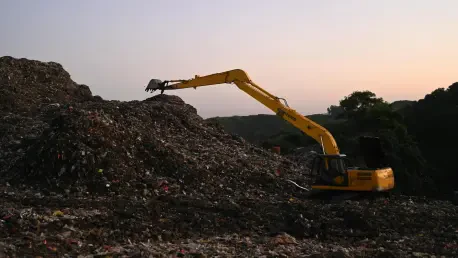In the heart of Colorado, a silent yet potent threat looms over the landscape as methane emissions from landfills contribute significantly to the escalating crisis of climate change, demanding urgent action from lawmakers and industry stakeholders alike. This greenhouse gas, released during the decomposition of organic waste like food scraps, possesses a warming potential far greater than carbon dioxide, despite lingering in the atmosphere for a shorter duration. As global temperatures climb, triggering extreme weather events from devastating storms to relentless floods, the need to curb methane has never been more pressing. Colorado stands at a crossroads, with the proposed Regulation 31 by the Air Quality Control Commission aiming to tackle this issue head-on. Yet, the path forward is fraught with tension as environmental imperatives clash with the practical and economic realities faced by the waste management sector. This complex challenge raises critical questions about achieving a sustainable equilibrium.
Environmental Imperatives Driving Change
Methane’s Outsized Impact on Climate
Methane, though less discussed than carbon dioxide, plays an outsized role in accelerating climate change due to its ability to trap heat at a rate many times higher over a short period. Landfills across the United States rank as the third-largest source of methane emissions, following natural gas and petroleum systems, with Colorado’s waste sites contributing significantly to this alarming statistic. Research from environmental organizations equates the impact of landfill methane to the exhaust from millions of gas-powered vehicles, painting a stark picture of the scale involved. As extreme weather patterns intensify, driven by rising global temperatures, the urgency to address near-term climate impacts through methane reduction becomes undeniable. Regulators in Colorado recognize that curbing these emissions could yield rapid benefits for the environment, potentially slowing the pace of warming in a way that other long-term strategies cannot match. This pressing need fuels the push for stringent policies, even as challenges loom on the horizon.
The Push for Proactive Solutions
Environmental advocates in Colorado argue that merely monitoring methane emissions from landfills falls short of addressing the root causes of the problem, pressing instead for transformative measures. Groups like the Environmental Defense Fund emphasize the importance of diverting organic waste, such as food scraps, away from landfills to prevent methane generation at the source. Such proactive strategies could significantly reduce emissions while fostering sustainable waste management practices across the state. However, implementing these solutions requires systemic changes, including robust composting programs and public education campaigns to encourage waste separation. The potential benefits are clear—less methane in the atmosphere translates to a measurable impact on climate goals. Yet, the road to adoption is paved with logistical hurdles, as infrastructure for large-scale waste diversion remains underdeveloped in many areas, complicating the transition to these forward-thinking approaches and sparking debate among stakeholders.
Industry Challenges and Economic Realities
Financial and Technical Barriers
Landfill operators and industry leaders in Colorado face substantial hurdles when it comes to complying with proposed methane reduction regulations like Regulation 31, primarily due to the financial and technical demands involved. Upgrading facilities to capture or mitigate methane often requires significant investment in equipment and infrastructure, costs that many operators warn could be passed on to consumers through higher tipping fees for waste disposal. Additionally, the technical feasibility of implementing such systems across diverse landfill sites varies widely, with older facilities potentially struggling to adapt to new standards. Industry representatives have voiced concerns that overly stringent rules might not only strain budgets but also disrupt operations, potentially leading to unintended consequences like reduced waste management capacity. Striking a balance between environmental mandates and operational realities remains a core challenge, as the state seeks solutions that avoid placing an undue burden on this critical sector.
Risk of Unintended Consequences
Beyond the immediate financial strain, stricter methane regulations carry the risk of broader unintended consequences that could undermine environmental goals in Colorado. Industry stakeholders caution that elevated disposal costs might incentivize illegal dumping, a practice that not only evades regulation but also exacerbates pollution in unregulated areas. Such outcomes could negate the benefits of methane reduction efforts, creating new environmental hazards in the process. Furthermore, the economic ripple effects of higher fees could impact municipalities and small businesses reliant on affordable waste management services, adding pressure to local economies. Addressing these risks requires careful policy design, ensuring that regulations are paired with support mechanisms like subsidies or phased implementation timelines. As discussions around Regulation 31 continue, finding ways to mitigate these potential downsides remains essential to crafting a framework that achieves sustainability without sparking counterproductive behaviors.
Navigating the Path Forward
Building a Collaborative Framework
As Colorado’s Air Quality Control Commission prepares to finalize decisions on Regulation 31, the importance of collaboration between environmentalists, industry leaders, and regulators has never been clearer. Past efforts revealed a deep divide, with public hearings showcasing the tension between those advocating for aggressive waste diversion and others prioritizing economic feasibility. Bridging this gap demands a framework that incorporates diverse perspectives, ensuring policies are both ambitious and achievable. Incentives for innovation, such as grants for composting infrastructure or tax breaks for compliant operators, could ease the transition for the industry while advancing environmental goals. Engaging local communities to support sustainable practices also emerged as a critical step, fostering a shared commitment to reducing methane. Reflecting on these discussions, it became evident that only through inclusive dialogue could a viable path be charted, one that addressed the urgency of climate action without sidelining practical constraints.
Reflecting on Sustainable Next Steps
Looking back, the journey to address landfill methane in Colorado highlighted the intricate dance between environmental necessity and economic pragmatism, with every step forward met by complex trade-offs. Final deliberations on Regulation 31 showed a commitment to progress, yet underscored the need for ongoing adaptation. Moving ahead, policymakers must prioritize scalable solutions like enhanced waste diversion programs, ensuring they are supported by adequate funding and public awareness initiatives. Providing technical assistance to landfill operators also proved vital, helping them meet new standards without compromising service delivery. Moreover, integrating community input into future revisions of such regulations stood out as a way to sustain momentum, ensuring that local voices shape the fight against climate change. These actionable measures, born from past challenges, offer a roadmap for not just mitigating methane but also setting a precedent for balancing ecological imperatives with industry needs in environmental policy-making.









